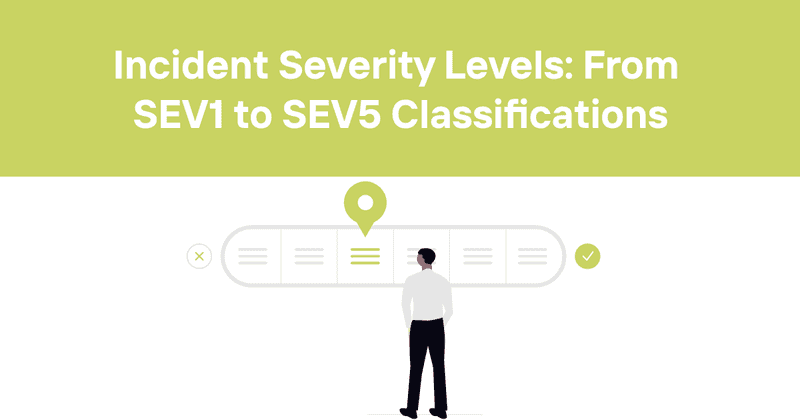Incident Severity Levels: From SEV1 to SEV5 Classifications
When an application goes down, a database crashes, or your website starts throwing errors, the chaos that ensues can quickly spiral out of control. Incident severity levels provide the structure needed to bring order to this chaos, helping teams determine how urgently they need to respond and what resources to allocate.
I've spent years working with incident management systems, and I've seen firsthand how proper severity classification can mean the difference between a minor hiccup and a full-blown crisis. Let's explore everything you need to know about incident severity levels and how to implement them effectively in your organization.
Table of Contents
- What Are Incident Severity Levels?
- The Standard 5-Level Severity Framework
- Customizing Severity Levels for Your Organization
- Factors That Influence Severity Classification
- Practical Examples of Incident Severity Levels
- Common Pitfalls in Severity Classification
- Severity Levels and Response Times
- Severity Level Escalation Procedures
- Documenting and Communicating Severity Levels
- Severity Levels in Post-Incident Reviews
- Incident Severity and SLAs/SLOs
- Tools for Managing Incident Severity
- Building a Severity-Based Incident Response Culture
- Conclusion
What Are Incident Severity Levels?
Incident severity levels are a classification system used to categorize incidents based on their impact on business operations, customers, and systems. These classifications help teams prioritize their response efforts, allocate appropriate resources, and communicate effectively about the situation.
Think of severity levels as the triage system in an emergency room. Just as medical professionals need to quickly assess which patients need immediate attention versus those who can wait, IT teams must determine which incidents require all hands on deck versus those that can be handled during regular business hours.
Severity levels typically range from critical (highest severity) to low (minimal impact), with various levels in between. The specific number of levels and their definitions can vary between organizations, but most follow a similar pattern.
The Standard 5-Level Severity Framework
While there's no universal standard that all organizations follow, a common approach is to use a 5-level severity framework. Here's a breakdown of how these levels typically look:
Severity 1 (Critical/SEV1)
- Impact: Catastrophic impact on critical business functions
- Scope: System-wide outage or severe degradation affecting most or all users
- Business effect: Complete inability to conduct core business operations
- Revenue impact: Significant and immediate revenue loss
- Response: Immediate, all-hands response required 24/7 until resolved
- Examples: Complete service outage, data breach in progress, payment system failure
A SEV1 incident means waking people up at 3 AM. It means the CEO might be getting calls from major customers. It's the "drop everything and fix it now" scenario.
Severity 2 (High/SEV2)
- Impact: Major functionality impaired
- Scope: Affects a significant subset of users or customers
- Business effect: Core functions severely impaired but not completely stopped
- Revenue impact: Potential revenue loss if not addressed quickly
- Response: Urgent response required, potentially 24/7 until resolved
- Examples: Partial system outage, significant performance degradation, security vulnerability with active exploitation risk
SEV2 incidents are serious but may not require waking everyone up in the middle of the night. They still need immediate attention during business hours and extended hours if necessary.
Severity 3 (Medium/SEV3)
- Impact: Moderate impact on business functions
- Scope: Affects a moderate number of users or non-critical functionality
- Business effect: Some operations impaired but workarounds may exist
- Revenue impact: Limited immediate revenue impact
- Response: Same-day response during business hours
- Examples: Non-critical feature unavailability, isolated performance issues, security vulnerabilities without immediate exploitation risk
A SEV3 incident needs attention soon but can typically be handled during normal business hours.
Severity 4 (Low/SEV4)
- Impact: Minor impact on business functions
- Scope: Limited to a small number of users or to non-essential functionality
- Business effect: Minimal disruption to operations
- Revenue impact: No immediate revenue impact
- Response: Planned response within days
- Examples: Cosmetic issues, minor bugs with easy workarounds, isolated errors affecting few users
SEV4 issues can be scheduled for resolution in the coming days or weeks.
Severity 5 (Informational/SEV5)
- Impact: Negligible impact
- Scope: Very limited, often affects single users or edge cases
- Business effect: No meaningful disruption to operations
- Revenue impact: None
- Response: Address as part of normal development cycle
- Examples: Documentation errors, feature requests, very minor bugs
SEV5 items are often treated more like feature requests or backlog items rather than true incidents.
This table summarizes the key aspects of each severity level:
| Severity Level | Response Time | Escalation | Business Impact | User Impact |
|---|---|---|---|---|
| SEV1 (Critical) | Immediate (24/7) | Executive management | Catastrophic | Most or all users |
| SEV2 (High) | Urgent (potentially 24/7) | Upper management | Major | Significant subset of users |
| SEV3 (Medium) | Same business day | Team leads | Moderate | Moderate number of users |
| SEV4 (Low) | Within days | Regular channels | Minor | Small number of users |
| SEV5 (Informational) | Regular development cycle | None required | Negligible | Very limited/single users |
Customizing Severity Levels for Your Organization
The standard framework is a starting point, but you'll need to adapt it to your specific organizational needs. A small startup might only need three severity levels, while a large enterprise with complex systems might need six or more.
When customizing severity levels, consider these aspects:
- Organization size and complexity: Larger organizations may need more granular classifications.
- Industry requirements: Regulated industries like healthcare or finance may have specific compliance considerations.
- Customer expectations: B2B companies with strict SLAs might need more precise severity definitions.
- Team structure: Your incident response capabilities should match your severity classifications.
For example, a financial services company might create a special "SEV0" category for incidents involving financial data breaches or transaction processing failures because the regulatory and financial implications are so severe.
On the other hand, a small e-commerce site might simplify to three levels:
- High: Site is down or checkout is broken
- Medium: Important features aren't working correctly
- Low: Minor issues that don't affect core functionality
Whatever framework you choose, make sure it's clearly documented and understood by everyone in the organization.
Factors That Influence Severity Classification
When determining the severity of an incident, several factors come into play:
1. User Impact
The number of users affected is often the primary factor in severity classification. An issue affecting 1% of users might be classified as SEV3 or SEV4, while the same issue affecting 50% of users could be SEV1 or SEV2.
2. Business Function Impact
Not all features are created equal. An outage in your payment processing system will likely be classified as higher severity than an issue with a secondary feature like user profile customization.
3. Revenue Impact
Direct revenue impact is a major factor. If an incident is actively preventing sales or causing financial loss, its severity is usually elevated.
4. Time and Duration
The timing of an incident matters. An issue occurring during peak business hours or a critical business event will typically receive a higher severity classification than the same issue occurring during off-hours.
Similarly, the longer an incident persists, the more likely it is to be escalated to a higher severity level.
5. Security and Data Considerations
Security incidents often have their own classification system, but they typically align with general incident severity frameworks. Data breaches, unauthorized access, and security vulnerabilities usually receive high severity classifications due to their potential impact.
6. Regulatory and Compliance Factors
In regulated industries, certain types of incidents may automatically trigger high severity classifications due to reporting requirements or compliance implications.
7. Visibility and Reputational Risk
Public-facing issues that could generate negative publicity might be classified with higher severity than internal issues, even if the technical impact is similar.
Practical Examples of Incident Severity Levels
Let's look at some real-world examples to better understand how these classifications apply in practice:
E-commerce Platform Examples:
- SEV1: Complete site outage during Black Friday sales
- SEV2: Checkout process failing for approximately 30% of customers
- SEV3: Product images not loading for certain categories
- SEV4: Search results displaying incorrect sorting order
- SEV5: Minor UI misalignment on product detail pages
SaaS Application Examples:
- SEV1: Multi-tenant database corruption affecting all customers
- SEV2: API rate limiting incorrectly applied, causing slowdowns for enterprise customers
- SEV3: Reporting feature generating incorrect data for the current month
- SEV4: Notification emails being delayed by several hours
- SEV5: Dashboard widget displaying outdated information until refresh
Banking System Examples:
- SEV1: Transaction processing system failure preventing all customer transactions
- SEV2: ATM network intermittently unavailable in multiple regions
- SEV3: Mobile app login issues affecting a subset of users
- SEV4: Delayed processing of non-critical batch operations
- SEV5: Formatting issues in monthly statement PDFs
I once worked with a financial services company that experienced what initially seemed like a SEV4 incident—some users reported occasional errors when viewing their account history. Within hours, we realized the issue was actually causing incorrect balance calculations for a small percentage of users. We immediately escalated it to SEV2 and assembled a cross-functional team that worked through the night to isolate and fix the problem.
This example illustrates an important point: severity levels aren't static. They can and should change as you learn more about an incident.
Common Pitfalls in Severity Classification
Several common mistakes can undermine the effectiveness of severity classification systems:
1. Severity Inflation
When too many incidents are classified as high severity, teams experience alert fatigue and may start ignoring alerts. Reserve your highest severity levels for truly critical issues.
2. Inconsistent Application
Without clear guidelines, different teams or individuals might classify similar incidents differently, leading to inconsistent responses.
3. Failure to Adjust Severity
As mentioned earlier, severity levels should be dynamic. If an incident becomes more severe during investigation or mitigation, the classification should be updated accordingly.
4. Ignoring Business Context
Technical teams sometimes focus solely on technical impact while overlooking business implications. A seemingly minor technical issue might have major business ramifications.
5. Overcomplicated Systems
If your severity classification system is too complex, people won't remember or apply it correctly. Keep it as simple as possible while still meeting your needs.
Severity Levels and Response Times
Each severity level should have clearly defined response time expectations. Here's a typical approach:
- SEV1: Immediate response (within minutes) with 24/7 effort until resolved or mitigated
- SEV2: Response within 30 minutes, with extended hours if needed
- SEV3: Response within 2-4 hours during business hours
- SEV4: Response within 1-2 business days
- SEV5: Response within 1-2 weeks or addressed in regular development cycles
These response times should be documented in your incident management procedures and potentially in customer-facing SLAs as well.
Severity Level Escalation Procedures
Sometimes incidents need to be escalated to higher severity levels. Clear escalation procedures are essential:
-
Trigger conditions: Define specific conditions that trigger automatic escalation (e.g., incident duration exceeding thresholds, spreading to additional systems, increasing user impact).
-
Escalation authority: Specify who can escalate an incident's severity level and under what circumstances.
-
Notification requirements: When an incident is escalated, additional stakeholders usually need to be notified. Document who needs to be informed for each severity level.
-
Resource allocation: Higher severity incidents require more resources. Your escalation procedures should outline how to quickly assemble those resources.
-
Management involvement: Define at what severity level executives and senior management should become involved.
For example, a typical escalation path might look like this:
- A SEV3 incident lasting more than 4 hours without resolution is automatically reviewed for potential escalation to SEV2
- Any incident that affects more than 20% of users is automatically escalated to at least SEV2
- The on-call incident commander has authority to escalate any incident by one severity level
- Escalation to SEV1 requires notification of the CTO/CIO and relevant department heads
Documenting and Communicating Severity Levels
Your severity classification system is only effective if everyone understands it. Documentation should include:
-
Clear definitions: Each severity level should have explicit, measurable criteria.
-
Examples: Provide concrete examples of what constitutes each severity level in your specific environment.
-
Response expectations: Document required response times, team involvement, and communication cadence for each level.
-
Decision authority: Specify who can declare incidents at each severity level.
-
Communication templates: Create templates for different severity levels to ensure consistent messaging.
This documentation should be readily accessible to all teams involved in incident response. Many organizations include it in their incident response runbooks or wikis.
Beyond documentation, regular training and simulations help teams internalize the severity framework and apply it effectively during real incidents.
Severity Levels in Post-Incident Reviews
Severity levels play an important role in post-incident reviews (also called postmortems):
-
Review requirements: Higher severity incidents typically require more thorough reviews. Many organizations mandate formal postmortems for all SEV1 and SEV2 incidents.
-
Attendance requirements: The required participants in a post-incident review often depend on the incident's severity.
-
Documentation detail: More severe incidents generally require more detailed documentation about causes, impacts, and remediation.
-
Follow-up actions: Higher severity incidents often generate more urgent action items to prevent recurrence.
During the review, it's also valuable to assess whether the incident was correctly classified:
- Was the initial severity appropriate?
- Was escalation or de-escalation handled correctly?
- Did the response match the severity?
These discussions can help refine your severity classification system over time.
Incident Severity and SLAs/SLOs
Service Level Agreements (SLAs) and Service Level Objectives (SLOs) are often directly tied to incident severity levels:
-
Response time SLAs: Most SLAs specify different response time commitments based on incident severity.
-
Resolution time targets: SLOs for resolution time typically vary by severity level.
-
Availability calculations: When calculating system availability for SLA purposes, different severity levels may be weighted differently.
-
Penalty structures: In commercial SLAs, financial penalties for breaches are often tiered based on incident severity.
For example, an SLA might specify:
- SEV1: 99.99% availability (52.6 minutes of downtime per year)
- SEV2: 99.9% availability (8.8 hours of downtime per year)
- SEV3: 99.5% availability (43.8 hours of downtime per year)
When designing your severity levels, ensure they align with your SLA commitments and vice versa.
Tools for Managing Incident Severity
Several tools can help manage incident severity effectively:
Incident Management Platforms
Dedicated incident management platforms like PagerDuty, Opsgenie, and VictorOps support severity-based workflows, including:
- Automatic routing based on severity
- Different notification methods for different severity levels
- Escalation paths tied to severity
- SLA tracking by severity level
Monitoring and Alert Systems
Modern monitoring tools allow you to define alert severity levels that align with your incident severity framework. This helps ensure that monitoring alerts generate appropriately prioritized incidents.
Status Page Tools
If you use a status page to communicate with customers during incidents, most platforms allow you to display different status indicators based on severity.
Odown, for example, enables you to customize status page communications based on incident severity, ensuring your customers receive appropriate information about the impact and expected resolution time of incidents.
Automation and ChatOps
For many organizations, automation plays a key role in severity-based incident response:
- Automatic creation of communication channels based on severity
- Pre-populated templates for different severity levels
- Automatic assembly of response teams
- Severity-based reporting dashboards
Tools like Slack integrations can automatically create incident channels with naming conventions that include severity levels (e.g., #inc-sev1-payment-outage), helping teams quickly understand the priority of various incidents.
Building a Severity-Based Incident Response Culture
Beyond systems and processes, effective incident management requires a culture that respects and appropriately responds to severity classifications:
-
Executive buy-in: Leadership must understand and support the severity framework, including being available when needed for high-severity incidents.
-
Respect for classifications: Teams should respect severity classifications and respond accordingly, without treating everything as an emergency or ignoring genuinely critical issues.
-
Blameless culture: When incidents occur, focus on fixing the problem and learning from it rather than assigning blame. This encourages accurate severity reporting.
-
Continuous improvement: Regularly review and refine your severity classifications based on experience and changing business needs.
-
Recognition of incident response: Acknowledge and appreciate the efforts of teams that respond to incidents, especially high-severity ones that require significant effort.
Building this culture takes time and consistent reinforcement, but it's essential for effective incident management.
Conclusion
Incident severity levels provide the framework that enables organized, prioritized response to technical issues. By clearly defining what constitutes different severity levels, establishing appropriate response procedures for each, and building a culture that respects these classifications, organizations can minimize the impact of incidents and maintain high service reliability.
Remember that your severity classification system should evolve as your organization grows and changes. What works for a small startup may not be sufficient for an enterprise, and specific incidents may lead you to refine your definitions and procedures.
With Odown's uptime monitoring, you can detect incidents early and automatically classify them based on severity. Our platform integrates with your existing incident management tools to ensure appropriate response based on severity levels. Additionally, Odown's SSL certificate monitoring helps prevent certificate-related outages by alerting you well before expiration, with severity-based notifications that align with your incident response framework.
The public status pages provided by Odown also support severity-based communication, allowing you to keep customers informed with appropriate messaging for each severity level. This transparent communication helps maintain trust even during incidents.
By implementing a clear, well-documented severity classification system and supporting it with the right tools and culture, you can turn the chaos of incidents into an organized, effective response that minimizes impact and maintains service reliability.



